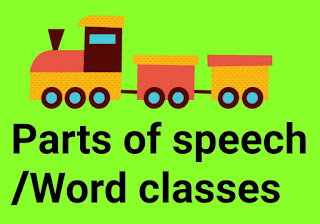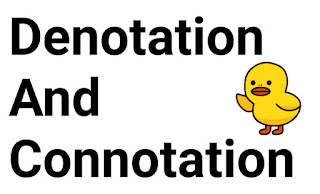PARTS OF SPEECH/ WORD CLASSES
Part of speech or word class are the labels we use to describe a word's grammatical function or the grammatical group to which it belongs. In the sentence she bought her lots of birthday presents, the word she is a subject pronoun. A pronoun is a part of speech that replaces a noun and refers to a person or a thing. There are nine parts of speech in English: nouns, verbs, adjectives, adverbs, determiners, prepositions, pronouns, conjunctions and exclamations.
Exercise 1
Look at the sentence below. There are two words beginning with wonder. What parts of speech are these two words?
She bought her lots of wonderful birthday presents: a wonderfully funny book and.....
A change to the form of a word can change the word's part of speech. In the sentence above, the adjective wonderful becomes the adverb wonderfully with the addition of the morpheme ly. This is called affixation: the addition of small units at the beginning, at the end or within words to change their meaning or part of speech. For example, possible - impossible (the meaning is changed by adding a prefix) and snow - snowy (the noun becomes an adjective by the addition of a suffix).
Exercise 2
Look at the two sentences below. What part of speech is spoken in each sentence?
1. I've spoken English for years.
2. Spoken English is sometimes hard to understand.
Answers
1. A verb. The past participle of speak. We know that spoken is a verb partly because it is preceded by a subject pronoun and that it is the past participle of speak because it follows the auxiliary have (the syntax), and has the letter o instead of ea in the middle and the letters -en at the end (the morphology).
2. An adjective. The past participle of speak. We can't tell this just from the morphology, but if we look at the syntax we can see that it is describing the noun English.
Sometimes, the form of a word remains the same but the part of speech changes because the function of the word changes. To help you decide what part of speech a word is, you need to consider following:
● its function in the sentence
● its form (morphology)
● its position in the sentence (syntax).
Adjective
Describes and gives more information about a noun, noun phrase or pronoun.
Examples: good, better (comparative), best (superlative), lovely
Adverb
Gives more information about adjectives, adverbs, verbs or whole phrases and sentences, e.g. by saying when or where something happens.
Examples: totally (degree), yesterday (time), quickly (manner)
Conjunction
Connects words, clauses or sentences and shows how they relate to each other.
Examples: but (contrast), and (addition), when (time)
Determiner
Tells you which noun is being referred to or tells you about quantity.
Examples: your (possessive), the (definite article)
Exclamation
Shows a feeling and is usually informal.
Examples: Hi! (friendly greeting), Er... (doubt)
Noun
Gives the name of things, people, places, etc.
Examples: party, kid (countable nouns), London (proper noun)
Preposition
Connects a noun, noun phrase or pronoun to other words or phrases and shows how they relate to each other.
Examples: at (place), towards (direction), before (time)
Pronoun
Replaces a noun or noun phrase.
Examples: you (personal, subject pronoun), mine (possessive pronoun)
Verb
Shows an action or state
Examples: could (modal), do (auxiliary), arrived (intransitive), have (auxiliary)



Comments
Post a Comment